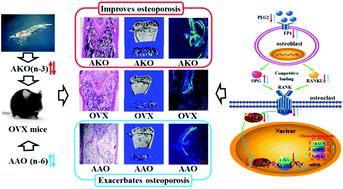当前位置:
X-MOL 学术
›
Food Funct.
›
论文详情
Our official English website, www.x-mol.net, welcomes your
feedback! (Note: you will need to create a separate account there.)
The opposite effects of Antarctic krill oil and arachidonic acid-rich oil on bone resorption in ovariectomized mice.
Food & Function ( IF 5.1 ) Pub Date : 2020-07-07 , DOI: 10.1039/d0fo00884b Qiping Zhan 1 , Yingying Tian 2 , Lihua Han 3 , Kai Wang 3 , Jingfeng Wang 3 , Changhu Xue 3
Food & Function ( IF 5.1 ) Pub Date : 2020-07-07 , DOI: 10.1039/d0fo00884b Qiping Zhan 1 , Yingying Tian 2 , Lihua Han 3 , Kai Wang 3 , Jingfeng Wang 3 , Changhu Xue 3
Affiliation

|
Osteoporosis, a chronic disease that affects over 200 million people worldwide, presents a substantial medical and socioeconomic burden on the modern society. However, long-term intake of diets supplemented with different polyunsaturated fatty acids (PUFAs) can affect bone metabolism; thus, this study investigated the comparative effects of Antarctic krill oil (AKO, containing n-3 PUFAs) and arachidonic acid-rich oil (AAO, containing n-6 PUFAs) on bone resorption in a mice model of postmenopausal osteoporosis. Mice were orally administered with AKO (200 mg kg−1) or AAO (220 mg kg−1) once daily for 30 days, ovariectomized, followed by the continued administration of the respective samples for 90 days. Biomechanical and histomorphometric analyses revealed that AKO increased the bone mineral density (BMD) to enhance the biomechanical properties by increasing the mineral apposition rate and repairing the microstructure of the trabecular bone, whereas AAO had the opposite effect. The fatty acid analysis of the vertebra showed that AKO increased the n-3 PUFA (especially for DHA) content, thereby decreasing the ratio of n-6/n-3 PUFAs, which was negatively correlated with the BMD. However, AAO had the opposite effect due to high amounts of arachidonic acid. To explore the underlying mechanism responsible for these observations, we compared the classical bone resorption OPG/RANKL/NF-κB pathway mediated by PGE2/EP4. The ratio of n-6/n-3 PUFAs in the bone affected the production of PGE2, a factor regulating the OPG/RANKL pathway, thereby regulating osteoclastogenesis by stimulating the NF-κB pathway. The results of ELISA, qRT-PCR, and western blot demonstrated that AKO reduced the secretion of PGE2 and the expression of EP4, upregulating the ratio of OPG/RANKL in the bone, thereby decreasing TRAF6 expression to inhibit the activation of the NF-κB signaling pathway, and finally inhibiting the expression of nuclear transcription factors (c-fos and NFATc1) to prevent excessive osteoclastogenesis (TRACP, MMP-9, and Cath-K). Arachidonic acid is a precursor of PGE2 synthesis. AAO showed the opposite trend through the same pathway. Thus, AKO could significantly improve osteoporosis via the OPG/RANKL/NF-κB pathway mediated by PGE2/EP4 to inhibit osteoclastogenesis, whereas AAO aggravated osteoporosis via the same pathway. This is the first study to systematically compare the effects and mechanism of AKO and AAO in regulating bone resorption in osteoporotic mice to support recommendations on fatty acid types in dietary oils for an osteoporotic population.
中文翻译:

南极磷虾油和富含花生四烯酸的油对去卵巢小鼠骨骼吸收的相反作用。
骨质疏松症是一种慢性病,全世界有2亿人受其影响,给现代社会带来了巨大的医学和社会经济负担。但是,长期摄入补充了不同多不饱和脂肪酸(PUFA)的饮食会影响骨骼代谢。因此,本研究在绝经后骨质疏松症小鼠模型中研究了南极磷虾油(AKO,含有n-3 PUFAs)和富含花生四烯酸油(AAO,含有n-6 PUFAs)对骨吸收的比较作用。给小鼠口服AKO(200 mg kg -1)或AAO(220 mg kg -1)),每天一次,持续30天,去卵巢,然后连续服用90天。生物力学和组织形态分析表明,AKO通过增加矿物质的附着率和修复小梁骨的微观结构来增加骨矿物质密度(BMD)以增强生物力学性能,而AAO则相反。椎骨的脂肪酸分析表明,AKO增加了n-3 PUFA(尤其是DHA)的含量,从而降低了n-6 / n-3 PUFA的比例,与BMD呈负相关。然而,由于大量的花生四烯酸,AAO具有相反的作用。为了探索造成这些现象的潜在机制,我们比较了PGE介导的经典骨吸收OPG / RANKL /NF-κB途径2 / EP 4。骨中n-6 / n-3 PUFA的比例影响PGE 2的生成,PGE 2是调节OPG / RANKL途径的因子,从而通过刺激NF-κB途径来调节破骨细胞的生成。ELISA,qRT-PCR和Western blot的结果表明,AKO减少了PGE 2的分泌和EP 4的表达,上调了OPG / RANKL的比例,从而降低了TRAF6的表达,从而抑制了NF的活化。 -κB信号通路,并最终抑制核转录因子(c-fos和NFATc1)的表达,以防止过度破骨细胞生成(TRACP,MMP-9和Cath-K)。花生四烯酸是PGE 2的前体合成。AAO通过相同的途径显示出相反的趋势。因此,AKO可以通过PGE 2 / EP 4介导的OPG / RANKL /NF-κB途径显着改善骨质疏松,从而抑制破骨细胞生成,而AAO可以通过同一途径加重骨质疏松。这是第一项系统地比较AKO和AAO在调节骨质疏松小鼠中骨吸收方面的作用和机制的研究,以支持对骨质疏松症人群食用油中脂肪酸类型的建议。
更新日期:2020-08-19
中文翻译:

南极磷虾油和富含花生四烯酸的油对去卵巢小鼠骨骼吸收的相反作用。
骨质疏松症是一种慢性病,全世界有2亿人受其影响,给现代社会带来了巨大的医学和社会经济负担。但是,长期摄入补充了不同多不饱和脂肪酸(PUFA)的饮食会影响骨骼代谢。因此,本研究在绝经后骨质疏松症小鼠模型中研究了南极磷虾油(AKO,含有n-3 PUFAs)和富含花生四烯酸油(AAO,含有n-6 PUFAs)对骨吸收的比较作用。给小鼠口服AKO(200 mg kg -1)或AAO(220 mg kg -1)),每天一次,持续30天,去卵巢,然后连续服用90天。生物力学和组织形态分析表明,AKO通过增加矿物质的附着率和修复小梁骨的微观结构来增加骨矿物质密度(BMD)以增强生物力学性能,而AAO则相反。椎骨的脂肪酸分析表明,AKO增加了n-3 PUFA(尤其是DHA)的含量,从而降低了n-6 / n-3 PUFA的比例,与BMD呈负相关。然而,由于大量的花生四烯酸,AAO具有相反的作用。为了探索造成这些现象的潜在机制,我们比较了PGE介导的经典骨吸收OPG / RANKL /NF-κB途径2 / EP 4。骨中n-6 / n-3 PUFA的比例影响PGE 2的生成,PGE 2是调节OPG / RANKL途径的因子,从而通过刺激NF-κB途径来调节破骨细胞的生成。ELISA,qRT-PCR和Western blot的结果表明,AKO减少了PGE 2的分泌和EP 4的表达,上调了OPG / RANKL的比例,从而降低了TRAF6的表达,从而抑制了NF的活化。 -κB信号通路,并最终抑制核转录因子(c-fos和NFATc1)的表达,以防止过度破骨细胞生成(TRACP,MMP-9和Cath-K)。花生四烯酸是PGE 2的前体合成。AAO通过相同的途径显示出相反的趋势。因此,AKO可以通过PGE 2 / EP 4介导的OPG / RANKL /NF-κB途径显着改善骨质疏松,从而抑制破骨细胞生成,而AAO可以通过同一途径加重骨质疏松。这是第一项系统地比较AKO和AAO在调节骨质疏松小鼠中骨吸收方面的作用和机制的研究,以支持对骨质疏松症人群食用油中脂肪酸类型的建议。









































 京公网安备 11010802027423号
京公网安备 11010802027423号